Top 5 Monorepo Tools for 2025
Monorepos can unlock significant productivity gains, but only if your team is prepared to invest in infrastructure, developer experience, and disciplined workflows.

TL;DR
- Monorepo tools like Bazel, Nx, Pants, and Turborepo help teams manage large codebases by offering incremental builds, caching, and dependency graph analysis—reducing CI/CD time and improving developer productivity.
- Bazel is powerful for complex, multi-language projects; Nx and Turborepo focus on JavaScript/TypeScript with advanced caching and task orchestration; Pants adds Python support with performance optimizations.
- Key features to compare include build speed, language support, extensibility, and ecosystem integration; some tools excel in enterprise monorepos, others in front-end-heavy projects.
- Best practices: combine monorepo tools with code ownership enforcement, selective test runners, and automated linters to keep large repos fast and maintainable.
- Migration isn’t trivial: teams must refactor build scripts, configure caching and CI, and train developers planning and phased rollout help avoid breaking builds or slow pipelines.
Managing multiple services, packages, and libraries across disparate codebases often becomes a logistical nightmare: version mismatches, redundant dependencies, scattered tooling. A monorepo offers a compelling fix, a single, version-controlled repository containing frontend, backend, shared libraries, and infrastructure definitions.
This structure dramatically simplifies cross-project dependency management, enforces consistent testing and linting, and makes internal code sharing almost frictionless. But as the codebase grows, fresh challenges emerge: lengthy build times, repetitive testing runs, CI pipeline slowdowns. That’s why you need powerful monorepo tools, specialized systems that detect changes, orchestrate builds selectively, and cache results effectively.
Development momentum stalls not just from scale but from poorly optimized workflows. As one Hacker News engineer put it:
“Having a system that can avoid running the test for many PRs because it can prove it’s not affected means … you don’t have to wait for that thing to run at all”.
But tooling at this scale doesn’t come cheap. “Managing large scale build systems ends up taking a team that works on the build system itself,” another commenter pointed out, and that often deters smaller engineering teams .
Suppose you want to go the monorepo route, do you pick Bazel, Pants, Nx, Turborepo, Gradle, or Lerna? Choosing isn’t trivial: each tool targets different languages, CI workflows, org sizes.
Even detractors see nuance. In a highly cited 2019 post titled “Monorepos: Please Don’t!”, Lyft engineer Matt Klein cautioned that large mono-repos demand the same infrastructure polyrepo teams build over time:
“At scale… a monorepo must solve every problem that a polyrepo must solve, with the downside of encouraging tight coupling, and the additional herculean effort of tackling VCS scalability.”
This line of criticism reflects real pain, slow git status, heavy tooling, and the need for IDE integrations and virtual file systems. But TechCrunch understands monorepos as a solution-solving architecture puzzle, not a binary choice.
Monorepos make sense when multiple services/modules need to be worked on together, released together, and tested as a whole. If you’re still deciding between monorepo vs polyrepo, this detailed breakdown can help clarify trade-offs based on team structure and workflow.
In this article, we dive into five monorepo tools that stand out in 2025, graded by language ecosystem, scale, CI integration, performance, and developer experience. We’ll help you choose the right tool for your stack and team size, without falling into hype or vanity metrics.
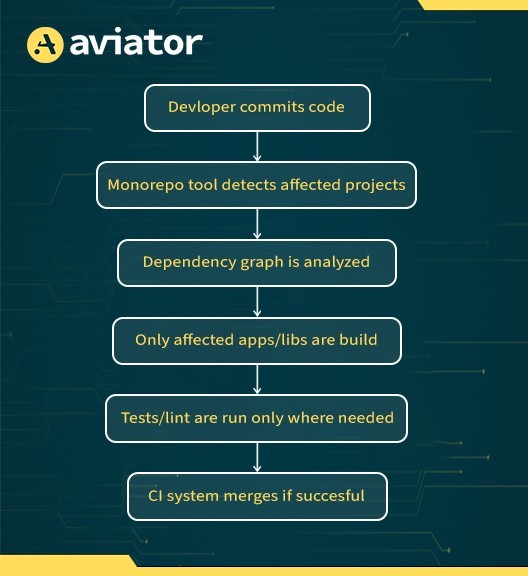
How to Choose the Right Monorepo Tool
Monorepos simplify project structure, but not all tools suit every stack or team size. Before picking a tool, consider three factors:
- Language and Framework Compatibility
Some tools like Nx and Turborepo are optimized for JavaScript/TypeScript ecosystems, while others like Bazel and Pants handle polyglot codebases spanning Go, Python, Java, and more. - CI/CD and Build Performance Needs
Tools like Bazel and Pants offer aggressive build caching and dependency tracking, ideal for organizations where CI pipelines span dozens of apps and packages. Others like Gradle or Lerna work well for smaller teams with simpler pipelines. - Team Workflow and Tooling Preferences
If your team already uses a specific build system (e.g., Gradle in JVM projects), monorepo tooling that integrates cleanly with it will save ramp-up time. Nx and Turborepo also provide built-in support for affected file detection and project graph analysis, which streamlines PR workflows. For readers newer to monorepos, this primer on what a monorepo is and why it matters lays out the benefits and common use cases clearly.
Choosing the right tool depends on your use case, not just raw performance benchmarks. Below, we’ve broken down the top monorepo tools for 2025, including who they’re best for and where they fit in real-world setups.
Best 5 Monorepo Tools for 2025
1. Bazel
Bazel is a production-grade build tool created by Google to manage one of the world’s largest monorepos. It is designed to handle polyglot codebases, strict build reproducibility, and massive CI workloads. Unlike most task runners or JavaScript monorepo tools, Bazel is language-agnostic and declarative.

Key Features
- Scalable dependency graph resolution: Bazel rebuilds only what is necessary by analyzing transitive dependencies.
- Remote caching and execution: Speeds up builds by caching outputs across machines or executing tasks remotely.
- Multi-language support: Works across Java, C++, Go, Python, TypeScript, and custom rules.
Ideal Use Case
While Bazel is extremely powerful, it’s not for the faint of heart. Originally built by Google to manage one of the world’s largest and most complex monorepos, Bazel carries the weight, and the quirks, of its internal origins. It’s fast, deterministic, and handles multi-language builds better than most tools out there. But it comes at a cost: steep learning curve, rigid configurations, and a dev experience that often feels tuned for Googlers, not generalist teams.
“Google has this reputation of: ‘we hire the smartest engineers, and therefore we can throw the most complicated tools at them,’” as one Bazel ecosystem founder put it.
If you’re a startup shipping a couple of node monorepo tools apps, Bazel will likely feel like overkill. But if you’re building SDKs, shared infra libraries, and dozens of microservices across multiple platforms, and you care about build reproducibility, caching, and scale, then Bazel is hard to beat.
That’s why companies like Airbnb, Stripe, and Dropbox have invested in Bazel setups, but also why entire ecosystems (like Aspect.dev) have emerged just to make Bazel usable for non-Google teams.
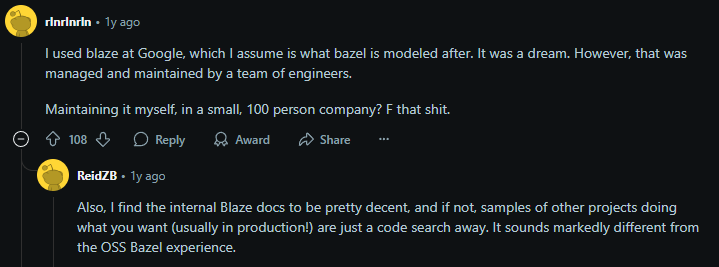
2. Gradle
Gradle is a flexible and extensible build tool that excels in managing multi-project builds, making it a practical choice for monorepos, especially in organizations with heavy Java, Kotlin, or Groovy usage and one of the best lerna alternatives. While it originated in the JVM ecosystem, Gradle has evolved to support multiple languages including C++, Python, and TypeScript through its plugin system.
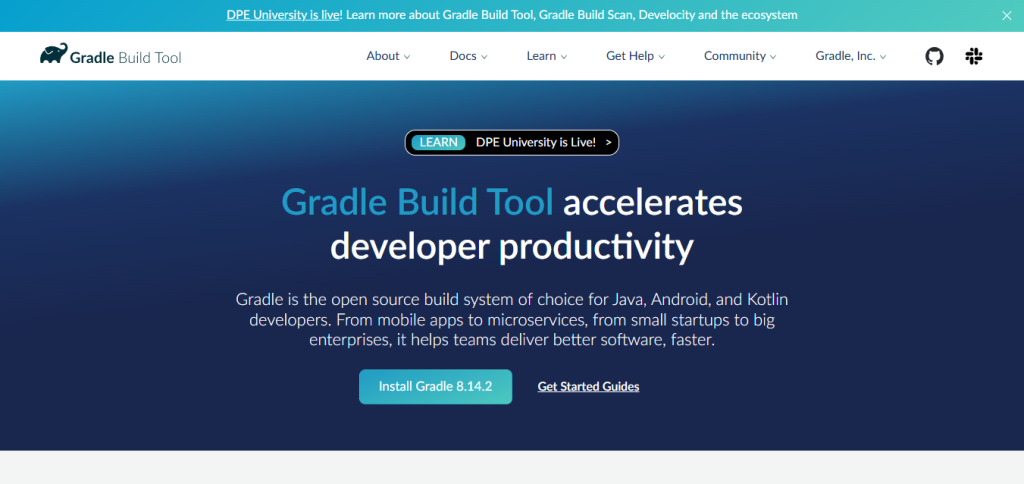
Key Features
- Multi-project build automation: Handles inter-project dependencies intelligently, enabling fine-grained task execution across hundreds of modules.
- Incremental and parallel builds: Avoids redundant work by tracking input/output changes and running builds concurrently.
- Cross-language plugin ecosystem: While JVM-first, Gradle’s plugin architecture allows teams to support JavaScript, Scala, C/C++, and native builds within the same repository.
Ideal Use Case
Gradle fits best in JVM-heavy stacks, think Java backends, Android apps, and shared Kotlin libraries. It’s not a monorepo tool per se, but its support for multi-project builds and mature plugin ecosystem makes it a viable option for large enterprises already deep into Gradle-based workflows.
“It’s powerful, but feels like a black box unless you’re already living in a Gradle world,” one developer noted.
If your CI is wired around Gradle and you’re managing shared modules across services, it’ll get the job done. Just be ready to configure a lot of the monorepo behavior yourself.

3. Turborepo
Turborepo is a high-performance monorepo build tools system optimized for JavaScript and TypeScript stacks. Built by Vercel and open-sourced in 2021, it targets modern frontend and full-stack teams using frameworks like Next.js, Node.js, and React. Unlike general-purpose build tools, Turborepo is designed specifically around developer velocity, local iteration speed, CI efficiency, and dependency-aware task execution.
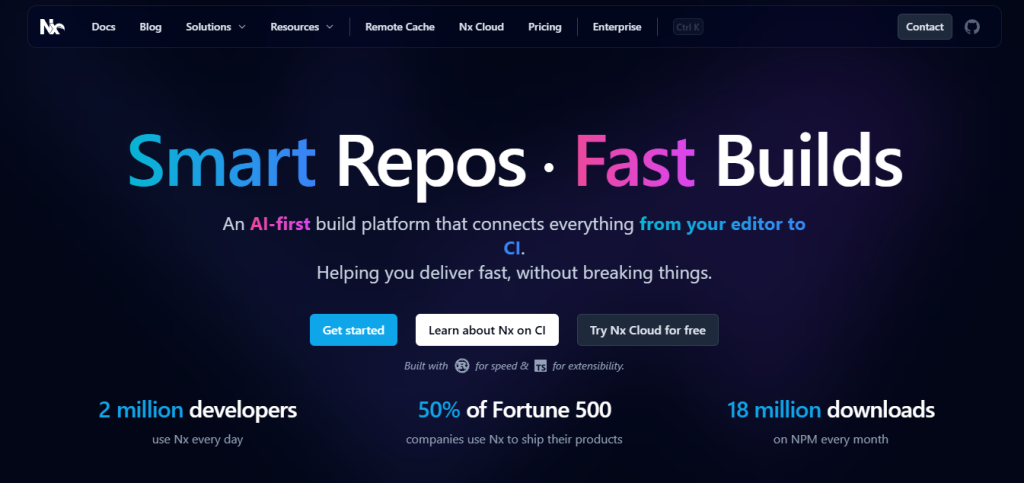
Key Features
- Incremental builds: Turborepo identifies what has changed in the dependency graph and only runs affected builds, tests, or linting tasks.
- Remote and local caching: Reuses computation results across machines or CI pipelines using Turbopack’s hashing engine.
- Framework-aware support: Works out of the box with Next.js, React, Node.js, and other common frontend/backend stacks.
Ideal Use Case
Turborepo shines for front-end-heavy or full-stack teams working in JavaScript/TypeScript. It excels when your monorepo contains multiple apps, web, mobile, admin dashboards, and shared packages like design systems, utilities, or API clients. With its smart task scheduling, workspace linking, and ultra-fast feedback loops, Turborepo turns what used to be slow CI runs into nearly instantaneous local builds.
“Turborepo does caching: when you’re running tests or building your monorepo, only those packages that changed will be re‑tested or re‑built.” one redditor put
These community insights highlight why Turborepo is often described as “monorepo light”: it’s simple to adopt, focused on performance, and lets you skip full rebuilds across multiple packages.

4. Pants
Pants is a fast, scalable build system built specifically for large-scale, multi-language monorepos. Unlike tools that evolved from single-language ecosystems, Pants was designed from the ground up to support heterogeneous codebases, often found in organizations running services in Python, Go, Java, and beyond. Its goal is to eliminate slow, brittle build pipelines by intelligently tracking dependencies and running only what’s needed.
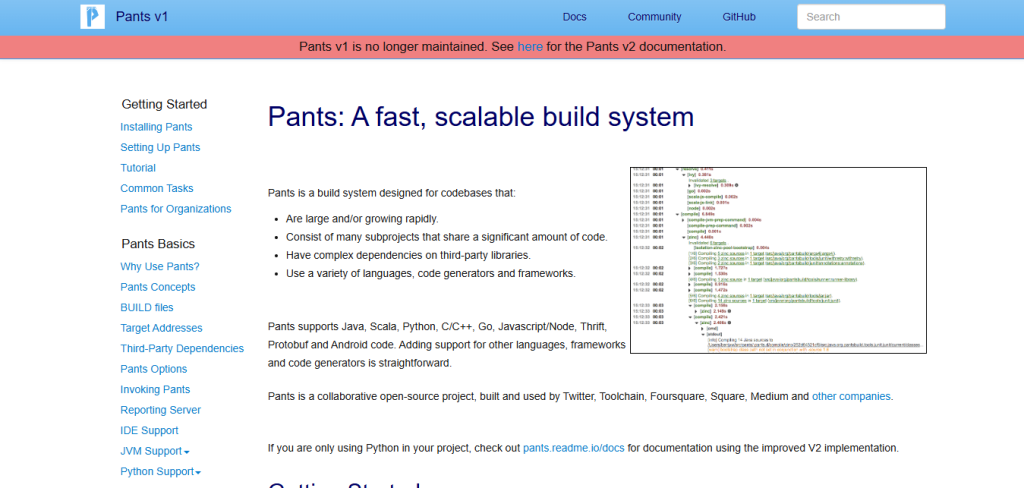
Key Features
- Precise dependency tracking: Pants analyzes source code and knows exactly which targets are affected by a change, avoiding wasteful full rebuilds.
- First-class support for multiple languages: Python, Go, Java, Scala, Shell, and more via plugins and extensions.
- Highly concurrent execution engine: Uses a rule engine to parallelize tasks across cores and machines.
Ideal Use Case
Pants is built for large, multi-language monorepos where performance and granularity matter. It excels at automatically inferring dependencies, speeding up incremental builds, and orchestrating tasks across python monorepo tools with minimal manual setup.
It’s not for small projects with only JavaScript or Python, but when you have dozens of services written in different languages, Pants gives you unified tooling without turning into a brittle build mess.
“Pants is MUCH easier and one of the best bazel alternatives to start with. It infers internal and external dependencies automatically so BUILD files are often trivial.” – company using Pants said

5. Nx
Nx is a powerful monorepo tool built specifically for managing JavaScript and TypeScript projects, though it’s extensible enough to support other stacks through custom plugins. Developed by former Angular core engineers, Nx started as a framework-centric tool but has evolved into a general-purpose monorepo orchestrator suitable for full-stack applications, libraries, design systems, and microservices.
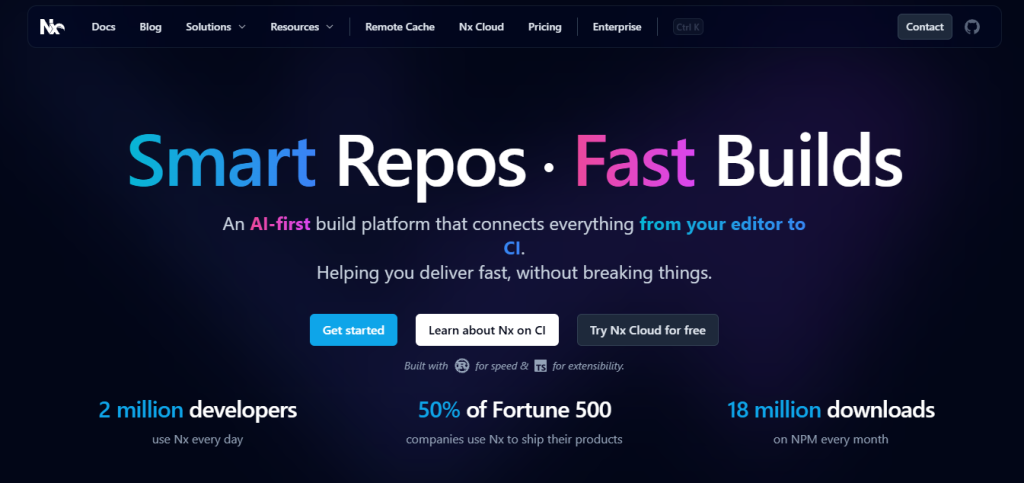
Key Features
- Smart dependency graph analysis: Nx builds a DAG (directed acyclic graph) of your workspace and uses it to run only what’s affected by a change.
- Distributed & local caching: Stores previous build/test results and skips repeated work locally or via remote cache services.
- Built-in generators: Easily scaffold libraries, apps, and services with enforced conventions.
Ideal Use Case
Nx is a heavyweight monorepo framework optimized for JavaScript/TypeScript at scale. It shines when your repo contains multiple frontends, APIs, shared libraries, and tools, letting teams manage complex dependency graphs, run only affected tasks, and use built-in generators for scalable codebases.
But Nx isn’t casual or lightweight, it brings structure and convention, along with complexity and configuration overhead.
“Absolutely. We migrated to Nx at work and the experience was excellent.” – a redditor said

How Aviator Helps Your Monorepo
Aviator is a developer productivity platform built to address some of the most painful bottlenecks in monorepo management, particularly in the pull request lifecycle: reviewing, merging, and testing. Unlike traditional dev tools that focus only on build orchestration or task scheduling, Aviator sits on top of your existing monorepo tooling stack and optimizes developer workflows with automation.

Key Features of Aviator
1. Merge Queue That Understands Real-World Builds
Aviator’s merge queue isn’t just about serializing PRs, it accounts for flakiness, test ordering issues, and infra quirks common in monorepo setups. If your CI passes 90% of the time but fails mysteriously on the last commit, Aviator helps isolate and stabilize those edge cases.
2. Built for Existing Monorepo Tooling
You don’t need to rework your entire stack. Aviator integrates with Bazel, Nx, Pants, Turborepo, Gradle, and others. It hooks into your existing workflows and understands how these tools run builds, track dependencies, and optimize tasks, without you replacing them.
3. Reviews That Aren’t Just Checklist Approvals
Aviator analyzes diffs in context. It highlights meaningful changes, surfaces who needs to review what, and flags parts of the code that are risk-prone. You can configure rules so performance-critical modules get extra scrutiny while small doc updates move faster.
4. Native Support for Stacked PRs
Instead of fighting Git to keep feature branches in sync, Aviator lets you break down large changes into smaller, reviewable PRs. It handles rebases, orders merges correctly, and makes sure that conflicts are handled upstream. No manual juggling needed.

Ideal Use Case
Aviator is ideal for engineering teams managing large-scale JavaScript/TypeScript monorepos, particularly those using tools like Nx, Lerna, or Turborepo. It’s especially helpful when:
- Pull requests pile up due to slow reviews or build queues.
- Developers frequently rebase or rewrite large changes to satisfy reviewers or fix flaky test failures.
- Merges are delayed by CI bottlenecks or out-of-order changes.
Is a Monorepo Worth It?
Monorepos offer undeniable advantages, simplified code sharing, atomic refractors, and unified tooling across teams. But they come with trade-offs: CI complexity, large checkouts, and the need for dedicated tooling support.
In r/ExperiencedDevs, one developer sums it up well:
“Monorepos makes local dev easy. One Git pull and run a script. All services and dependencies running from master on your machine.”
They’re particularly valuable when code sharing is central to your workflow.
But other voices serve as a caution:
“If you have teams to support the development experience… monorepos are worth it. If not, developers are going to be frustrated because off the shelf tools will not be able to scale.”
And yet:
“Monorepos are as good as the devs behind them. If you have a stellar dev team, a monorepo can be great. If your dev team…isn’t stellar, a monorepo will become an enormous liability.”
Our opinion? Monorepos can unlock significant productivity gains, but only if your team is prepared to invest in infrastructure, developer experience, and disciplined workflows. Lightweight stacks with smart caching (especially via tools like Nx, Turborepo, or Pants) can mitigate many traditional pain points. But remember: no tool is a silver bullet.
Choose your path intentionally. If you prioritize shared libraries, atomic changes, and you can support CI/tooling complexity, a monorepo backed by the right tools is more than worth it. If not, a smaller polyrepo setup may still serve you better, and save you years of frustration.
Frequently Asked Questions
1. What are monorepo tools?
Monorepo tools are specialized build orchestration and task execution systems designed to manage codebases that combine multiple services, libraries, or applications in a single repository. They enable efficient builds, version tracking, dependency isolation, and parallel testing across projects. Instead of running full CI pipelines or redundant tests, monorepo tools detect exactly what has changed and only run the required steps.
2. What is the best monorepo tool?
There’s no universal “best” monorepo tool, it depends on your tech stack and team scale:
For large enterprises with polyglot builds: Aviator
For TypeScript/JavaScript projects with modular code: Nx or Turborepo
For npm/Yarn workspaces in need of version publishing workflows: Rush
For blazing-fast JS builds with CI focus: Lage
Evaluate based on your language ecosystem, caching needs, and CI/CD setup.3. Do I need a monorepo tool?
If your repository holds multiple packages or services that are interdependent, and if your team struggles with slow CI times, build duplication, or inconsistent tooling, then yes, a monorepo tool will likely improve your workflow. These tools eliminate overhead, improve developer feedback loops, and bring predictability to large-scale development.
However, if you manage only one or two services with minimal shared code, the complexity introduced by some monorepo tools may not be worth it.4. Is Google still using monorepo?
Yes, Google continues to use one of the largest monorepos in the industry. Their internal build system, Blaze (the internal version of Bazel), underpins the daily work of thousands of engineers. The monorepo houses everything from search infrastructure to machine learning models, built and deployed via Bazel. This enables cross-team collaboration, centralized versioning, and unified CI pipelines at a scale unmatched by most companies.









